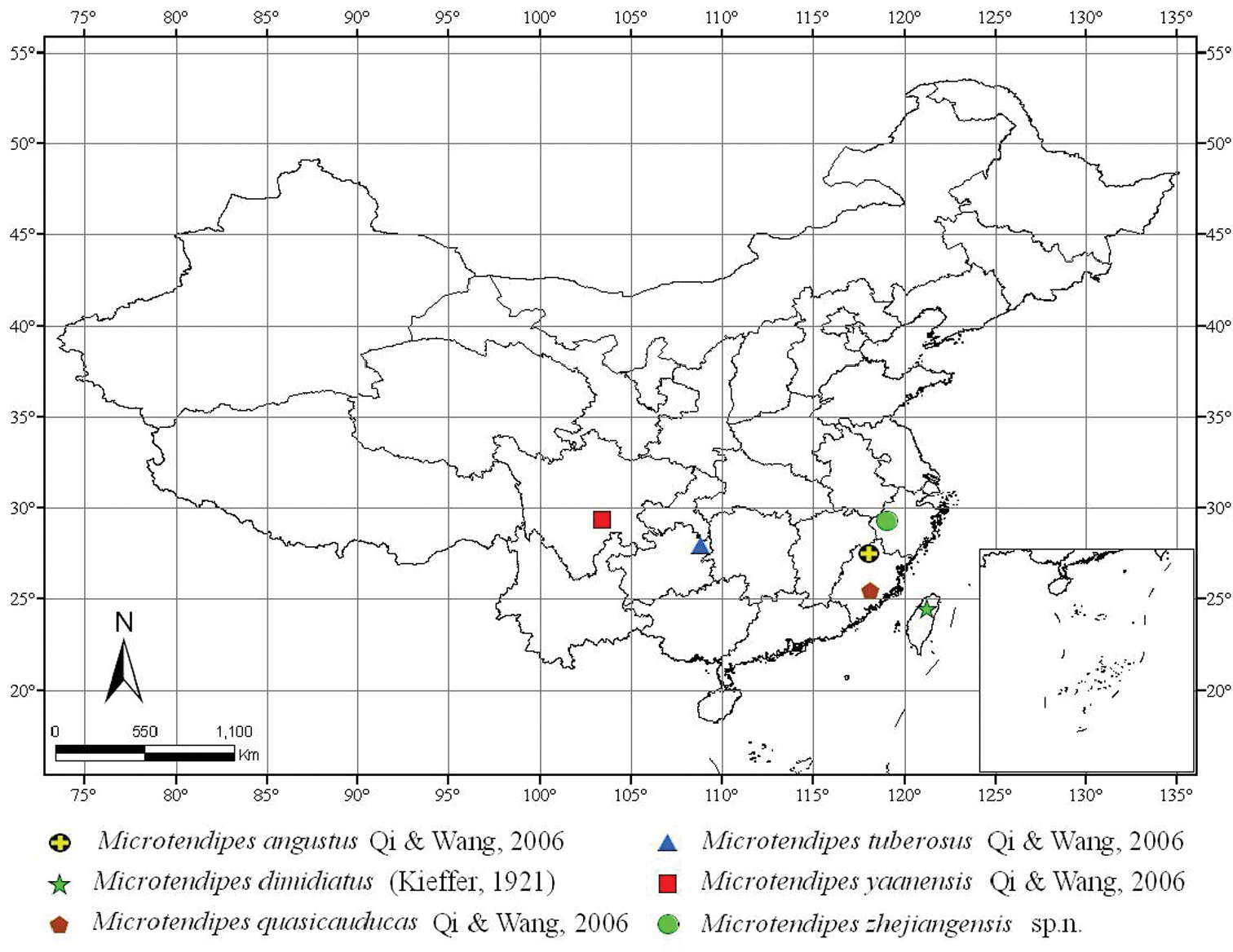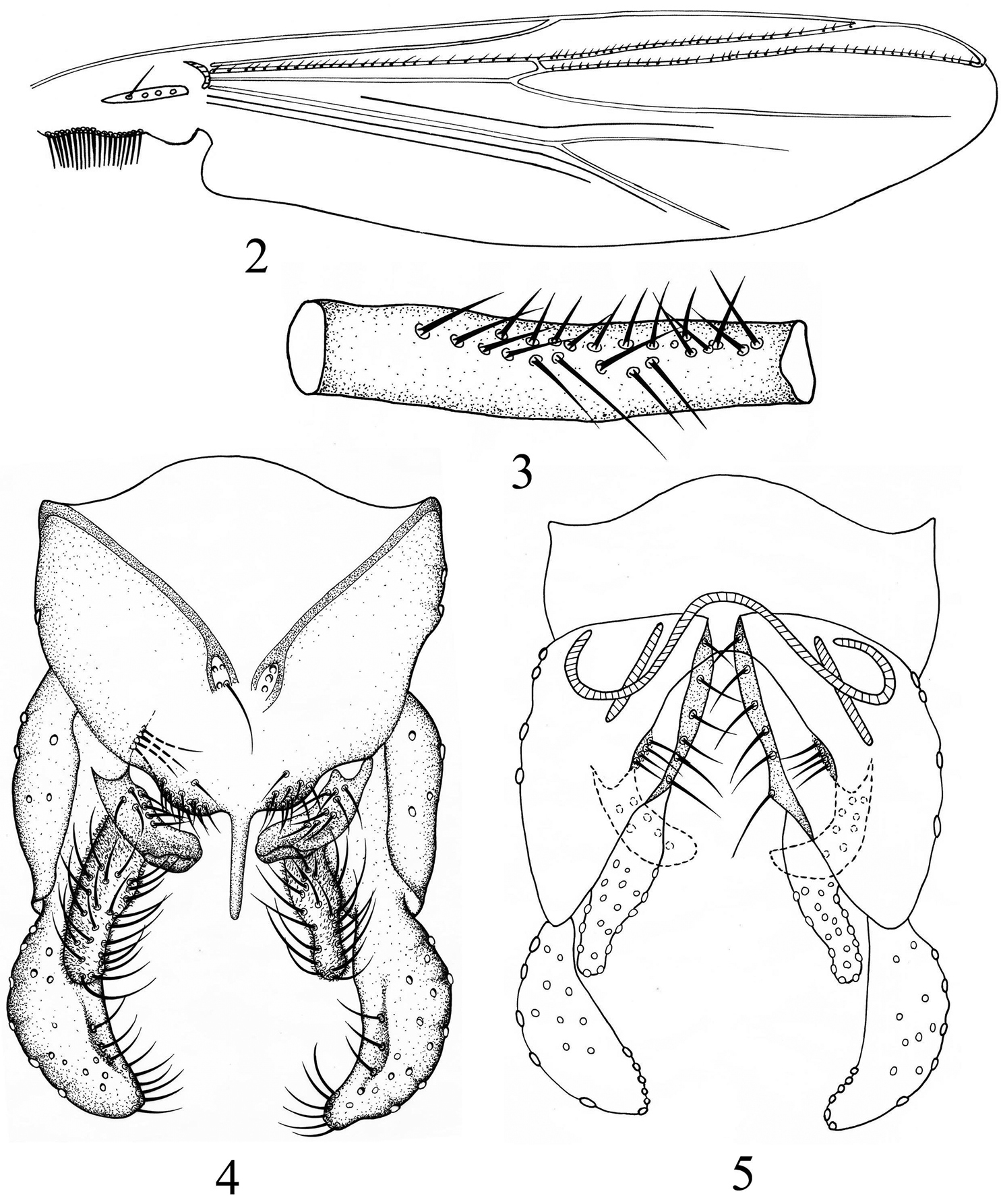






(C) 2012 Xin Qi. This is an open access article distributed under the terms of the Creative Commons Attribution License 3.0 (CC-BY), which permits unrestricted use, distribution, and reproduction in any medium, provided the original author and source are credited.
For reference, use of the paginated PDF or printed version of this article is recommended.
A new species of the genus Microtendipes Kieffer, 1915, Microtendipes zhejiangensis sp.n., is described, and its morphological description and illustrations are given. A catalogue of the genus in Oriental Region is provided and a key to the males of Microtendipes in the Oriental Region is given.
Microtendipes, new species, key, catalogue, Oriental Region
Microtendipes Kieffer, 1915 is a cosmopolitan genus, occurring in all zoogeographical regions. Immature stagesof Microtendipes are found in littoral and sublittoral sediments of large water bodies, with a few species occurring in running water (
The Oriental Region includes all of Asia south and east of the Himalayan Mountains (India and South East Asia), as well as southern China and the Islands of Southwestern Japan, Indonesia and Philippines. There was no catalogue of Microtendipes for the Oriental Region before this work, some previous records of Oriental Microtendipes are as follows:
In this contribution, a new species of Microtendipes from Oriental China is described; the type localities map of the genus Microtendipes in Oriental China is given (Fig. 1); a catalogue and a key to the species of Microtendipes from the Oriental Region are presented.
The type localities map of the genus Microtendipes in Oriental China.
The morphological nomenclature follows
http://species-id.net/wiki/Microtendipes
Tendipes abbreviatus Kieffer, 1913 [= Chironomus chloris (Meigen, 1818)]
Most males of Microtendipes can be distinguished from all other Chironomini by one or two rows of stout, proximally directed setae on the fore femur. Additionally, the hypopygium of some species generally has a tubercle or wart-shaped median volsella often bearing a tuft of long setae. Species without the above characters require association with immature stages for correct placement in the genus; moreover, Microtendipes can be divisible into two species-groups (pedellus group and rydalensis group) with recourse to immature stages. The characters of larva are as follows: the body is large, red to orange coloured, up to 15 mm long; the antenna has 6 segments; the lauterborn organs alternate on apices of segments 2 and 3; the mandible has 3 inner teeth; the median trifid is either pale or as dark as remaining teeth with very small median tooth (maybe absent); the lateral and ventral tubules are absent.
Palaearctic, Oriental, Nearctic, Neotropical and Australian regions.
Microtendipes angustus Qi & Wang, 2006
Microtendipes angustus Qi & Wang, 2006: 38.
Oriental China (Fujian, Guizhou Province).
Microtendipes britteni (Edwards, 1929)
Chironomus (Microtendipes) britteni Edwards, 1929b: 399.
Microtendipes britteni (Edwards):
Oriental China (Guangdong, Guizhou, Zhejiang Province)
Microtendipes chloris (Meigen, 1818)
Chironomus chloris Meigen, 1818: 28
Microtendipes chloris (Meigen):
Oriental China (Zhejiang Province)
Microtendipes dimidiatus (Kieffer, 1921)
Chironomus (Microtendipes) dimidiatus Kieffer, 1921: 581
Oriental China (Taiwan Province)
Microtendipes iriocedeus Sasa & Suzuki, 2000
Microtendipes iriocedeus Sasa & Suzuki, 2000: 3, 12.
Southwestern Japan (Iriomote Island)
Microtendipes pedellus (De Geer, 1776)
Tipula pedellus De Geer, 1776: 378
Chironomus aberrans Johannsen, 1905: 221
Microtendipes pedellus (De Geer):
Oriental China (Guizhou, Zhejiang Province); South India
Microtendipes quasicauducas Qi & Wang, 2006
Microtendipes quasicauducas Qi & Wang, 2006: 41.
Oriental China (Fujian Province)
Microtendipes schuecki Reiss, 1997
Microtendipes schuecki Reiss, 1997: 271.
Thailand (DoI Inthanon)
Microtendipes tobaquintus Kikuchi & Sasa, 1990
Microtendipes tobaquintus Kikuchi & Sasa, 1990: 301.
Indonesia (Toba Lake)
Microtendipes truncatus Kawai & Sasa, 1985
Microtendipes truncatus Kawai & Sasa, 1985: 18;
Oriental China (Zhejiang, Fujian, Guizhou, Yunnan Province)
Microtendipes tuberosus Qi & Wang, 2006
Microtendipes tuberosus Qi & Wang, 2006: 43.
Oriental China (Guangdong, Guizhou, Hainan Province)
Microtendipes yaanensis Qi & Wang, 2006
Microtendipes yaanensis Qi & Wang, 2006: 45;
Oriental China (Zhejiang, Sichuan Province)
| 1 | Hypopygium with median volsella | 2 |
| – | Hypopygium without median volsella | 7 |
| 2 | Superior volsella with lateral lobe | 3 |
| – | Superior volsella without lateral lobe | 5 |
| 3 | Wing with dark markings | Microtendipes schuecki |
| – | Wing transparent, without markings | 4 |
| 4 | Front femur with small tubercle | Microtendipes tuberosus |
| – | Front femur without small tubercle | Microtendipes yaanensis |
| 5 | Anal point subtriangular | Microtendipes pedellus |
| – | Anal point parallel sided | 6 |
| 6 | Superior volsella hook-like | Microtendipes chloris |
| – | Superior volsella broad, rounded apically | Microtendipes truncatus |
| 7 | Inferior volsella abruptly narrowed in apical half | 8 |
| – | Inferior volsella digitiform | 9 |
| 8 | Anal point apically slightly swollen and rounded; superior volsella with 4 dorsal setae, 2 basal setae | Microtendipes angustus |
| – | Anal point parallel-sided, slender, apex rounded; superior volsella with 7−10 dorsal setae, 4 long basal setae | Microtendipes zhejiangensis sp.n. |
| 9 | Wing with dark markings | Microtendipes quasicauducas |
| – | Wing transparent, without markings | 10 |
| 10 | Abdominal tergite VIII narrowed at base, as inverted V-shaped | Microtendipes iriocedeus |
| – | Abdominal tergite VIII not narrowed at base | 11 |
| 11 | Anal point parallel-sided, slender, apex rounded | Microtendipes tobaquintus |
| – | Anal point subtriangular, with pointed apex | Microtendipes britteni |
# The record of Microtendipes dimidiatus was only based on female, so the key does not include it.
urn:lsid:zoobank.org:act:96DD36A0-80C8-4175-9F46-33AC31F7E6B4
http://species-id.net/wiki/Microtendipes_zhejiangensis
Figs 2−5The male imago can be distinguished from known species of the genus by the following combination of characters: superior volsella hook-like, apex obtuse, with 7−8 dorsal setae and 4 long basal setae; median volsella absent; absence of pigment marks in wing; acrostichals 2−3.
Male imago (n = 3). Total length 5.75−6.05 mm. Wing length 3.38−3.48 mm. Total length/wing length 1.65−1.79. Wing length/length of profemur 2.25−3.71.
Coloration. Head yellow. Thorax greenish yellow with scutum and postnotum brown. Abdomen greenish yellow, Abdominal tergites I−VI pale green, tergites VII−IX and hypopygium brown. Legs: apical 1/3 of fore femur, basal 1/2 of fore tibia and apical 1/10 of tibiae brown; remaining parts greenish yellow.
Head.AR 1.82−2.48. Temporal setae 16−19 including 6−8 inner verticals, 6−10 outer verticals, and 2−3 postorbitals. Clypeus with 37−38 setae. Tentorium 205−240 mm long, 55−70 mm wide. Palpomere lengths (in mm): 60−65, 63−73, 310−330, 330−350, 460−480. L: 5th/3rd 1.39−1.54.
Wing(Fig. 2). VR 1.07−1.13. B with 4 setae; R with 27−28, R1 with 24−32, R4+5 with 31−49 setae. Squama with 18−20 setae.
Thorax. Dorsocentrals 17, acrostichals 2−3, prealars 4. Scutellum with 10−25 setae.
Legs(Fig. 3). Distal half of front femur with 23−25 proximally directed setae in 2 rows, 180−200 mm long. Spur on median tibiae 25−33 mm long including 28−30 mm long comb, unspurred comb 25−33 mm long; spur on posterior tibia 33−40 mm long including 25−33 mm long comb, unspurred comb 28−30 mm long. Width at apex of front tibia 80−87 mm, of middle tibia 83−85 mm, of hind tibia 90−95 mm. Lengths (in mm) and proportions of legs in Table 1.
Hypopygium(Figs 4−5). Anal point 78−90 mm long, parallel-sided, slender, apex rounded. Tergite IX with 6−9 long setae medially and 22−36 setae along posterior margin. Phallapodeme 90−113 mm long; transverse sternapodeme 50−70 mm long. Gonocoxite 223−238 mm long. Superior volsella 105−125 mm long, hook-like, apex obtuse, with 7−10 dorsal setae and 4 long basal setae. Inferior volsella digitiform, 110−140 mm long, narrowed in apical 1/2, with 29−32 setae. Gonostylus 143−148 mm long, with 9−10 setae along inner margin in distal 1/2. HR 1.51−1.64, HV 4.08−4.32.
Female, pupa and larva are unknown.
Holotype: 1♂, China, Zhejiang: Kaihua County, Gutian Mountain, 29°14.27’N, 118°07.13’E, 7.iv.2011, Lin XL, sweeping method. Paratype: 2♂♂, same as holotype.
The species is named after the type locality, using the Latin suffix –ensis, denoting place of origin.
The new species is similar to Microtendipes pedellus (De Geer), but can be separated from Microtendipes pedellus (De Geer) on the basis of the following: (1) presence of median volsella in Microtendipes pedellus (De Geer), with 3 long setae in the median volsella; whereas absence of median volsellain Microtendipes zhejiangensis sp.n.; (2) the inferior volsella of Microtendipes pedellus (De Geer) digitiform, with 20 setae, whereas the inferior volsella of Microtendipes zhejiangensis sp.n. narrowed in apical 1/2, with 29−32 setae; (3) HV of Microtendipes pedellus (De Geer) 2.98−3.36, whereas HV of Microtendipes zhejiangensis sp.n. 4.08−4.32.
The new species is also similar to Microtendipes nitidus (Meigen, 1818). The superior volsella of Microtendipes nitidus (Meigen) has a basal expansion bearing more than 5 long setae mesally, but the superior volsella of Microtendipes zhejiangensis sp.n. is not expanded basally, with 4 long basal setae separated from each other.
This new species can be separated from Microtendipes quasicaducas Qi & Wang on the basis of the following characters: (1) the anal point of Microtendipes quasicaducas Qi & Wang slender, tapering from base, and apically pointed; whereas the anal point of Microtendipes zhejiangensis sp.n. parallel−sided, slender, apex rounded; (2) the wing with pigment marks in Microtendipes quasicaducas Qi & Wang, but the wing without marks in Microtendipes zhejiangensis sp.n.; (3) the acrostichals 2−3 in Microtendipes zhejiangensis sp.n., whereas the acrostichals of Microtendipes quasicaducas Qi & Wang lacking.
This new species can also be separated from Microtendipes zhamensis Qi & Wang, 2006 on the basis of the following characters: (1) the anal point of Microtendipes zhamensis Qi & Wang slender, pointed; whereas the anal point of Microtendipes zhejiangensis sp.n. parallel-sided, slender, apex rounded; (2) presence of median volsella in Microtendipes zhamensis Qi & Wang, with 2 setae in median volsella; absence of median volsellain Microtendipes zhejiangensis sp.n.; (3) the inferior volsella of Microtendipes zhamensis Qi & Wang digitiform, with 24 setae; whereas the inferior volsella of Microtendipes zhejiangensis sp.n. narrowed in apical 1/2, with 29−32 setae; (4) the acrostichals 2−3 in Microtendipes zhejiangensis sp.n., whereas the acrostichals of Microtendipes zhamensis Qi & Wang lacking.
The species is known from Zhejiang Province of China.
Lengths (in µm) and proportions of legs of Microtendipes zhejiangensis sp.n. (n = 3).
| P1 | P2 | P3 | |
|---|---|---|---|
| fe | 1375−1500 | 1625−1700 | 1875−1875 |
| ti | 1550−1700 | 1525−1575 | 1700−1800 |
| ta1 | 1900−2075 | 1025−1100 | 1250−1300 |
| ta2 | 875−975 | 525−550 | 750−825 |
| ta3 | 875−950 | 420−450 | 575−600 |
| ta4 | 775−825 | 275−290 | 350−360 |
| ta5 | 325−350 | 150−150 | 150−160 |
| LR | 1.21−1.22 | 0.68−0.72 | 0.71−0.72 |
| BV | 1.70−1.72 | 3.00−3.04 | 2.52−2.64 |
| SV | 1.54−1.55 | 2.93−3.05 | 2.83−2.90 |
| BR | 2.21−2.50 | 3.40−3.75 | 2.67−4.75 |
Microtendipes zhejiangensis sp.n., male. 2 wing 3 two rows of directed setae in front femur 4 hypopygium (dorsal view) 5 hypopygium (ventral view).
Financial support from the Zhejiang Provincial Natural Science Foundation of China (Y3100486, Y3110395), the National Natural Science Foundation of China (NSFC, grant No. 30570207, J0630963), Fauna of China (FY120100) and the Science Foundation of Taizhou University (No. 2012QN18) are acknowledged with thanks.

